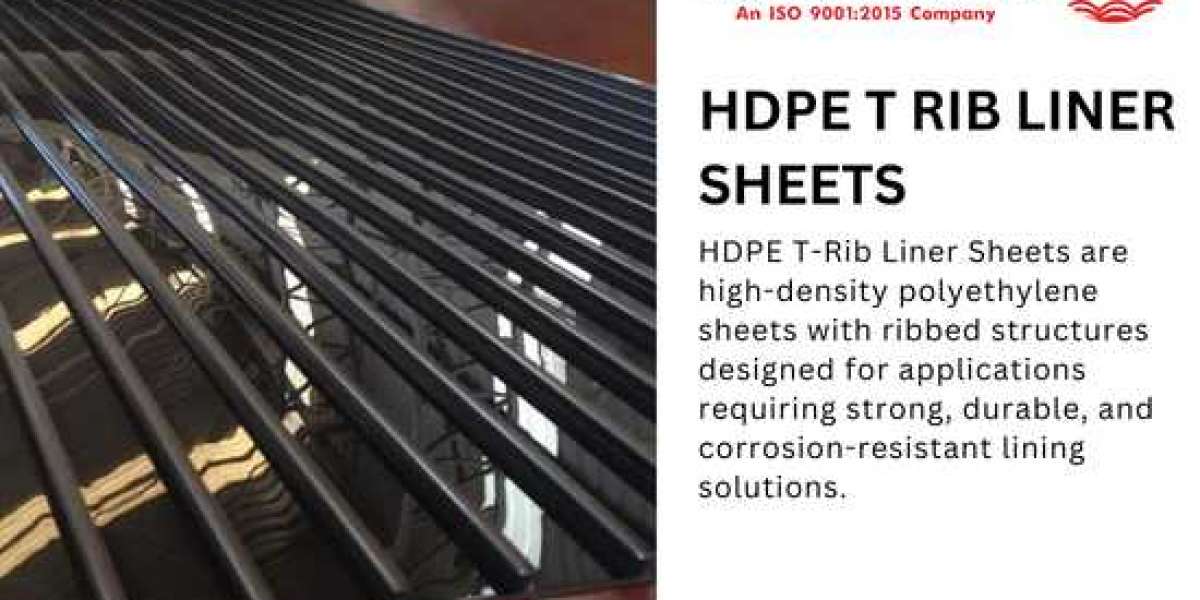HDPE T Rib Liner Manufacturers in Ahmedabad are becoming increasingly popular in various industries for their versatility, durability, and cost-effectiveness. Whether you're in construction, agriculture, or landscaping, these sheets offer a reliable solution for containment, protection, and reinforcement needs. In this article, we delve into the features, applications, and frequently asked questions about HDPE T-Rib liner sheets to help you make informed decisions.
What are HDPE T-Rib Liner Sheets?
HDPE (High-Density Polyethylene) T-Rib liner sheets are robust plastic sheets with a unique ribbed structure, designed for enhanced strength and stability. These sheets are manufactured using high-quality HDPE material, ensuring resistance to chemicals, UV rays, and environmental wear and tear. The T-Rib pattern provides additional rigidity, making them suitable for various demanding applications.
Applications of HDPE T-Rib Liner Sheets:
Pond and Canal Linings: Liner Sheet Manufacturers in Gujarat are widely used for lining ponds, canals, and reservoirs to prevent seepage and water loss. The durable construction ensures long-term protection against leaks and contamination, making them ideal for water storage and conservation projects.
Landfill Liners: In waste management facilities, HDPE T-Rib liner sheets serve as reliable barriers to contain hazardous materials and prevent groundwater contamination. Their puncture resistance and chemical stability make them indispensable for landfill lining systems, ensuring environmental safety and regulatory compliance.
Agricultural Applications: Farmers utilize HDPE T-Rib liner sheets for various agricultural purposes, including silage pits, effluent tanks, and irrigation channels. These sheets safeguard crops, livestock, and the surrounding environment by preventing seepage of chemicals, fertilizers, and effluents into the soil and water sources.
Geomembrane Linings: Civil engineering projects such as dams, reservoirs, and irrigation systems benefit from HDPE T-Rib liner sheets as cost-effective geomembrane linings. Their high tensile strength and puncture resistance provide reliable containment for liquids and solids, ensuring structural integrity and longevity.
Advantages of HDPE T-Rib Liner Sheets:
Durability: Liner Sheet Supplier in Ahmedabad are engineered for durability, withstanding harsh environmental conditions, chemical exposure, and mechanical stress without degradation or loss of performance.
Flexibility: Despite their robustness, HDPE T-Rib liner sheets remain flexible, allowing for easy installation around contours and irregular surfaces without compromising structural integrity.
Chemical Resistance: These sheets exhibit excellent resistance to a wide range of chemicals, including acids, alkalis, and solvents, making them suitable for containment applications in chemical processing plants, industrial facilities, and laboratories.
UV Stability: UV stabilization additives ensure that HDPE T-Rib liner sheets maintain their structural integrity and color stability even when exposed to prolonged sunlight, extending their service life in outdoor applications.
Cost-Effectiveness: Compared to traditional lining materials such as concrete or clay, HDPE T-Rib liner sheets offer a more economical solution, reducing installation time, labor costs, and maintenance expenses over the long term.
Conclusion:
HDPE T-Rib liner sheets offer a versatile, durable, and cost-effective solution for a wide range of containment, protection, and reinforcement applications across various industries. With their exceptional strength, flexibility, and chemical resistance, these sheets provide reliable performance and long-term value, making them an indispensable choice for modern engineering and environmental projects. By understanding their features, applications, and advantages, you can confidently incorporate HDPE T-Rib liner sheets into your next project for enhanced efficiency and sustainability.
FAQs (Frequently Asked Questions):
Q1: Are HDPE T-Rib liner sheets recyclable?
A1: Yes, HDPE T-Rib liner sheets are recyclable and can be reprocessed into new products at the end of their service life, contributing to sustainable waste management practices.
Q2: How do I determine the appropriate thickness of HDPE T-Rib liner sheets for my application?
A2: The thickness of HDPE T-Rib liner sheets depends on factors such as the type of containment, the nature of the stored materials, and the environmental conditions. It is recommended to consult with a technical expert or supplier to select the optimal thickness for your specific requirements.
Q3: Can HDPE T-Rib liner sheets be welded or joined together on-site?
A3: Yes, HDPE T-Rib liner sheets can be welded or heat-sealed on-site using specialized equipment and techniques to create seamless joints and ensure watertight integrity.
Q4: Are HDPE T-Rib liner sheets suitable for use in potable water applications?
A4: Yes, HDPE T-Rib liner sheets are approved for use in potable water applications, as they meet stringent safety and quality standards for contact with drinking water.



